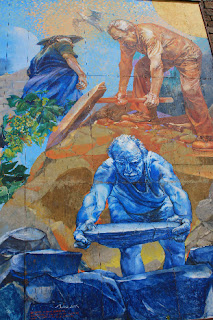Rosemary's Travel Diary
Jane led us to our hotel, where street parking was forbidden and the manager knew only one word of English: "Reservation?" This was not a problem, just my opportunity to prove I speak enough Italian to communicate on the relevant issues. After we unloaded our bags, Steve went off to find a legal parking spot, and was, fortunately, able to do so just a few blocks away. We asked the manager for a restaurant recommendation and followed his directions to an "authentic, not tourist" trattoria. Its appearance was good, but when we stepped inside it was unbearably hot (which may explain why there were only two other customers), so we hastily exited and set off to find a place on our own. We picked a place that had a sidewalk dining area. It seemed authentic enough, as all the other customers were Italian. Dinner was good, and we went back to the hotel where the manager asked us what time we wanted breakfast. What we learned was that he had only five small tables available in the breakfast area, so reservations were necessary. He hadn't thought to ask us when we first checked in, and by now all the good times were taken, so we had to settle for 7:30am, about an hour and a half earlier than we had planned.
Sat - As it turned out, our early breakfast had an unexpected benefit. We were out of the hotel in time to find a new parking spot before they became completely unavailable, and we arrived on foot at the Campo dei Miracoli (Field of Miracles) before the big crowds. Steve decided he would climb the famous tower if tickets were available. Only a small number of people can enter at a time, and it's necessary to purchase tickets for a specific time slot in advance. Because we were there relatively early, he was able to get a ticket for the next group. I stayed on the ground and snapped pictures of him waving from the top.
It didn't take long for the area to fill with people. We entered the cathedral, but could not visit the baptistry because it was closed for renovations. We are used to something always being closed for renovations. Keeping these centuries-old structures in usable condition requires a lot of maintenance.
Traffic and parking in Pisa is a real nightmare. The road in was crowded last night, and the road out was even more crowded this morning (and the road in was now even worse). People were simply pouring in, on foot, in buses, and in cars. I felt as though we were facing an invading army.
On the Autostrada, we stopped at an Autogrill for a lunch of toasted sandwiches. They were quite tasty and just the fuel we needed to keep on going. [Steve: The Autogrills are pretty interesting. They can be as simple as an AM/PM style convenience store, with fast food and bottled or canned drinks, or as complex as a modern truck stop, with different types of food, a coffee bar, shops, supplies, and items you would never think of buying while traveling, like an inflatable children’s playhouse.] The Autostrada is a toll road. When you enter, you get a ticket stamped with your time and location. When you exit, you pay based on how far you have come. At some point, I realized our ticket was missing. Apparently when we cleaned some trash out of the car at the Autogrill, someone (who shall remain nameless) had discarded the ticket as well. We didn't know what would happen, but I envisioned an expensive penalty. I began coaching Steve to say, "Ho perso il biglietto." The Bologna exit was one that was all automated, no live attendants in the booths. Yikes! But there is actually always at least one person supervising, so Steve pushed the red help button and repeated the phrase into the speaker. Somehow, the guy didn't seem to understand. I imagine that lost tickets are rare, and he may never have encountered the situation before. At first he apparently thought Steve was trying to say that we were lost. So I talked to him and managed to explain it. We ended up paying 11.00E, which was probably what we would have paid anyway.

The tower isn't the only thing to see in Pisa.
Here's a section of the ceiling inside the cathedral.


























 />
/>













































